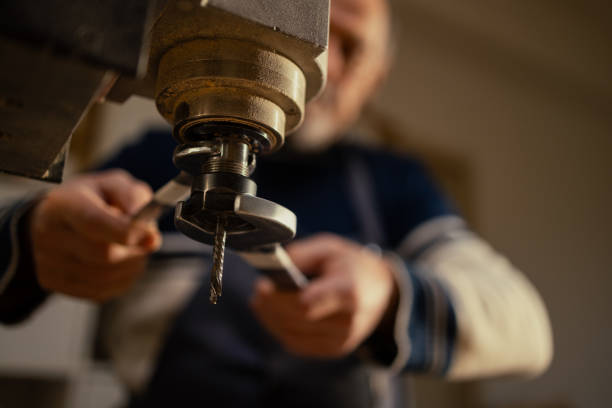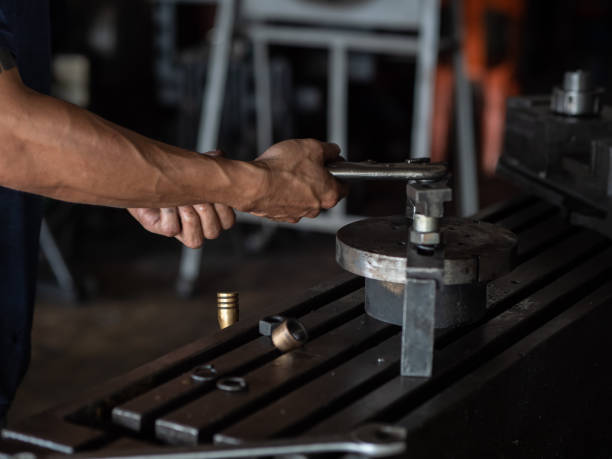CNC machines or computer numerical control machines are a necessity in modern-day manufacturing. These machines help you in attaining efficient and precise production lines. Their efficiency is unparalleled since they are machinery equipment so they can get broken. Some types of malfunctions can be treated with repairs while others require you to change the machinery equipment. The usual choice in such cases is to invest in used CNC machinery which is available at cheap rates compared to new parts and is efficient enough to keep the production running. In some cases, some manufacturers invest in an altogether used CNC machine if they are tight on budget to keep the assembly line working.
Of course, used machinery needs more care and maintenance to make sure you get the most out of it and keep it functional. In this article you can get acquainted with the basic understanding of what a used CNC machine is and the expert tips for used CNC machine repair.

Understanding the used CNC machines: Before we move to the expert tip for repairing, it is essential to understand the basics of used CNC machines. The new machines are surely in an unmatchable working condition while the used ones have faced routine wear and tear as they have been in use previously. This wear and tear means that the machine might face some problems in the near future such as electrical faults, component degradation, and alignment issues. A seemingly minor defect can disrupt the entire production line and affect the production quality. To repair the parts or machinery properly, you need to assess all these factors carefully as identifying the root cause is equivalent to solving half the problem. By identifying the main cause you can deal with the problem in an efficient manner and devise an effective repair strategy.
Now that you are acquainted with the understanding of used CNC machines and machine components, it is time to unveil the expert tips for used CNC machine repair. The need for repair does not indicate a low-quality component. Daily wear and tear and mishandling can dysfunctional a high-quality component. So, never believe in the general perception that the component of a used CNC machine malfunctioned because it was of compromised quality.
Here are the expert tips for used CNC machine repair that can help you understand the different types of malfunction and tips to deal with those issues and bring back the used CNC machine to optimal function. Following these tips will not only help you to alleviate the performance of used CNC machines but also add to the useful life of the machine.

• Diagnostic techniques and tools: To successfully repair a CNC machine, it is essential to use thorough diagnostic techniques and tools. Diagnosing the real cause behind malfunction or breakdown is the first step in efficient repair. Modern and complex CNC machines require modern tools for appropriate diagnosis. By incorporating advanced tools like CNC diagnostic software, oscilloscopes, and multimeters, you can identify the root cause that is disrupting the efficient function of the CNC machine. Along with diagnostic tools, it is also necessary to conduct functional tests and visual inspections. These tactics aid in pointing out any anomaly in machinery and mechanical malfunction. Opting for a mix of traditional diagnosis measures (visual inspection) and sophisticated measures (latest tools) is the best diagnosis strategy and ensures that you identify the real cause of machine dysfunction.
• Calibration and alignment: CNC machines operate optimally when they are well-calibrated and aligned. With time and daily wear and tear, it is common for the components to get out of alignment which can lead to imprecise machine operation. To work on proper alignment it is essential to follow the manufacturer’s instructions along with opting for precision measurement tools. Through these instructions and tools expert technicians can reset the alignment of CNC machine components and recalibrate systems to ensure the machine works optimally.
• Malfunctioned component inspection and replacement: When it comes to used CNC machinery, it is essential to inspect individual components because most of the time one minor defect in a particular component can be the reason for functional malfunction in a CNC machine. Commonly the components that face wear and tear include ball screws, bearings, electrical wiring, and belts. When inspecting these components, you must look for any sign of abrasion, irregular surface texture, and cracks as these are the classic signs that the component needs replacement. It is essential to replace these damaged parts with well-functioning and high-performing parts to make sure that CNC performs optimally. It also lowers the risk of sudden breakdowns that can hinder operations and disrupt the production cycle.
• Electrical troubleshooting: One of the common issues that used CNC machines face is related to electrical malfunction. It can occur in various ways such as circuit faults intermittent power supply or malfunctioning control panels. No matter in which form the electrical issues arise, they can disrupt the entire functioning of the CNC machine and can even result in a machine breakdown. It is essential to thoroughly inspect the electrical components of used CNC machines including connectors, cables, wiring, and circuit boards. You can also run tests on electrical circuits for voltage, continuity, and adequate operations using tools such as oscilloscopes or multimeters. Inspection helps the expert technicians diagnose the electrical issue and rectify it effectively to ensure that the machine performs optimally.
• Software optimization: Now that you know the hardware repair that used CNC machines commonly require, it is important to understand that these are not the only issues that arise in CNC machines. They can also face software issues for which you need immediate repairing to make sure that the CNC machine software is optimized and offers you superior performance. There are many steps that you need to ensure software optimization such as recalibrating control systems, tuning machine programs, and updating the installed firmware to lower cycle times and enhance performance. In addition to these strategies, you can also data integrity through regular backups and lower downtime by implementing maintenance schedules.
• Precision measurement: When repairing or replacing the CNC machine components, you must incorporate precision measurement tools to accurately measure the tolerance and dimensions of components. Many tools can help you in this regard such as micrometers, calipers, and dial indicators. Precise measurement makes sure that the component you have repaired/replaced fits accurately and seamlessly. This ensures that the machine will operate optimally after the installation of the repaired/replaced component.
• Quality components for replacement: If the component of a used CNC machine is completely damaged and can't be repaired then it is time to replace it. You can replace it with a used component. The only consideration that you need in this regard is the compatibility and quality of the component that you have chosen as the replacement. To ensure the quality of components, always look out for manufacturers who have a good rapport for quality components that are long-lasting and adequately manufactured. Using components that are substandard can compromise the performance of used CNC machines and result in machine failures. Customer reviews and market standing are the best metrics to identify manufacturers who offer superior-quality CNC machine parts.
• Adequate installation and handling: always make sure that you assign the repair task to an expert who is knowledgeable about installation and handling of various components. The expert must be acquainted with the repair manual shared by the manufacturer along with appropriate procedures for assembly, disassembly, and component installation. By following the best practices with expert knowledge and professional aptitude, you can repair the damaged component efficiently and get your used CNC machine back to running in no time.
• Safety measures: When repairing used CNC machines, safety should be your utmost priority. It is required that you wear adequate personal protective equipment, follow the manufacturer’s repair instructions, and follow appropriate lockout procedures. These steps lower the inherent risk of injuries and accidents that can happen during repair. In addition, it is essential to provide comprehensive and thorough training to maintenance professionals and CNC machine operators to ensure they are acquainted with all safety protocols and deal with the machinery with the required level of care and professionalism.
• Preventive strategies: You must have heard that prevention is better than cure. This concept applies to CNC machinery as well. You can apply preventive strategies to lower the need for repairs and prolong the useful life of used CNC machines. To do so, you need to conduct scheduled inspections on a regular basis, clean any debris to protect the parts from clogging, lubricate moving components to aid in consistent movement, and identify potential problems with components to deal with before they affect production. In addition, it helps to document any maintenance that you have applied and track machine performance through various metrics. It helps you to ensure continuous improvement of parts that need attention and aids in proactive decision-making regarding repair and replacement needs.